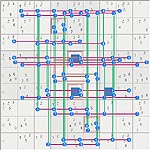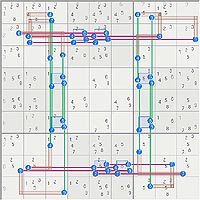Hi ttt,
On finding how to present deductions, I found this but not sure…
Based on Steve’s concept for SK loop, look 4’s, 6’s, 7’s, 9’s on row 2&8 and col. 3&7 with 16 “true” and boxes 2,3,4.6.7.8.9 each box contain max. two “true” for 4,6,7,9 then:
1- If box 1 contains two “true” => SK loop and deduct some…
2- If box 1 contain three “true” => some cases with 4’s, 6’s ,7’s at r2c1, r2c2, r1c3, r3c3 and one of boxes 2,3,4,6,7,8,9 contain only one of 4’s, 6’s, 7’s, 9’s
Then I found something quite interesting but not sure and need your help, I’m too headache…
I promised somethinn. I don't know if it will help, but this is one step in your direction.
This is based partly on "virus patterns", AC2 with specific properties I ahve described one year ago in my main post "full tagging".
http://forum.enjoysudoku.com/viewtopic.php?t=5624&postdays=0&postorder=asc&start=0These virus patterns are one way to describe SK loop. As we have here a "Nearly complete SK loop", your can work with them.
- Code: Select all
1238 123478 1247 |2479 234579 4579 |3459 12345 6
236 2347 5 |24679 234679 1 |8 234 239
1236 9 1246 |246 23456 8 |345 7 1235
---------------------------------------------------------
1569 157 1679 |8 4679 2 |345679 13456 13579
5689 578 3 |4679 1 4679 |2 4568 5789
4 1278 12679 |5 679 3 |679 168 1789
---------------------------------------------------------
1235 6 124 |1247 24578 457 |357 9 23578
259 245 8 |3 245679 45679 |1 256 257
7 1235 129 |1269 25689 569 |356 23568 4
Here after the "Nearly SK loop" with non conform patterns at both ends;
- Code: Select all
r2c12 r2c89 r13c7 r79c7 r8c89 r8c12 r79c3 r23c1
467 23 23 49 49 35 35 67 67 25 25 49 49 12 12 467
X Y X Y X Y X Y X Y X Y X Y
The main properties of "virus patterns" are summarized here below
from left to right #Y => #Y and X => X
#(2&3)r2c89 => #(4&9)r3c17 . . . => #(4&9)r79c3 => #(2&3)r23c1
(2&3)r2c12 => (4&9)r2c89 . . . => (1&2)r79c3 => 2 fo (467) r23c1from right to left #X => #X and Y => Y
#(1&2)r79c3 => #(4&9)r8c12 . . . => #(4&9)r2c89 => #(2&3)r2c12
(1&2)r23c1=>(4&9)r79c3 . . . =>(4&9)r13c7 => 2 of(467) r2c12if #Y and #X we have at least one valid on each end giving on general property of virus pattern chains:
In a virus pattern chain, at minimum, 2 out of the four digits in the ends are true.This is extended here to "2 of the six digits", so a minimum of 2 out of
4r2c2;6r2c1;7r2c3 4r13c3;6r3c3;7r3c3
are true.Now one finding of the solver :
(4&9)r2c89 is not validHe did it thru complex AICs nets, but you can show it in a very simple equivalent way along the "virus patten chain"
(4&9)r2c89 =>(3&5)r13c7 => (6&7)r79c7 => (2&5) r8c89 => (4&9) r8c13 => (1&2)r79c3
After partial cleaning we see that r5c46 must be 49, but then we have a deadly pattern for 67 in column 5.
- Code: Select all
1238a 123478A 47â |2479 234579 45S79 |35 1e2 6
236t 237à 5 |267 2367 1 |8 4 9
1236 9 46V |246 2345P6 8 |35 7 1E2
-----------------------------------------------------------------------
156 157 679 |8 4n679 2 |4o79 1356 1357
568A 578 3 |4679 1 46w79 |2 568 578
4 12b78å 679 |5 679 3 |79 168 178
-----------------------------------------------------------------------
3g5 6 12 |1d24 2458c 45 |7 9 38C
9i 4H 8 |3 67 67 |1 25 25
7 3G5 12 |1D269 2568C9 569 |6x 38c 4
This gives a second clue: we can not have (1&2) r13c3.
One at least out of 4r13c3;6r3c3;7r3c3 must be true.
That's all for the time being. I hope it can help you.
BTW, it shows as well that some of my solver findings can be improved in a "very simple way".
champagne



